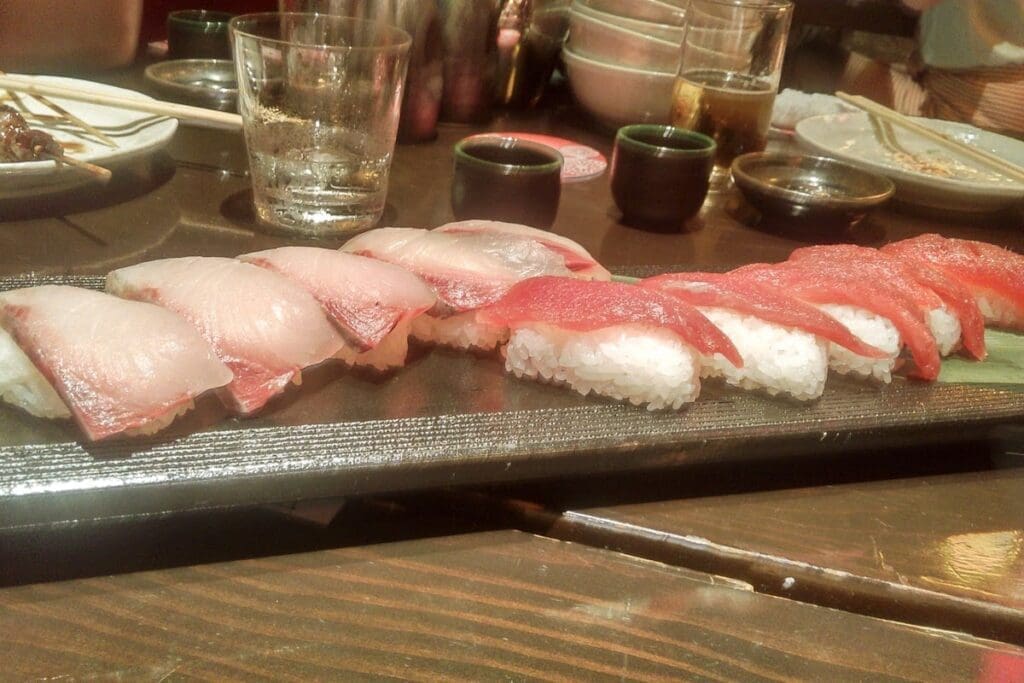When you hear the word sushi, the first country that comes to your mind is likely Japan. And when we hear about Japanese food, the first dish that comes pops in the head of most people is sushi. But did you know that sushi actually didn’t originate from Japan but from another country? Read on to understand where sushi come from, and why everybody makes this confusion.
How Sushi was Invented: A Journey from China to Japan
Here’s what most people don’t know: sushi actually originated in China, not Japan. We’re talking about ancient times—around the 4th century BC. The Chinese had a practical reason for creating it. They would ferment fish in rice to preserve it. The rice was later discarded and only the fish was consumed.
As trade and travel ramped up between China and Japan, the art of fermenting fish in rice found its way across the water. But how did the Japanese make it their own?
Sushi in Japanese Cuisine: The Creation of Modern Sushi
Fast forward to Japan taking on the concept somewhere around the 8th century AD. They took it to a new level, making the dish not just about preservation but also about taste. The rice wasn’t thrown away anymore; it was eaten with the fish.
In the 17th century, vinegar started getting added to the mix. The rice got tastier and didn’t need to ferment for as long. Sushi, as we know it today, started taking shape.
By the 19th century, sushi had really caught on in Japan, becoming a kind of fast food sold at stalls. You might wonder why it became so popular in Japan but not in its birthplace, China. Stay tuned for that.

Chinese vs Japanese Sushi: A Comparative Look
Sushi in China and Japan might share a common ancestor, but they’ve evolved quite differently over the years.
In China, you’ll often find more types of sushi that are deep-fried or include additional spices. The Chinese also have a fondness for rolls filled with crispy and crunchy ingredients.
Japan, on the other hand, values the subtlety of each ingredient. The sushi there is often a simple combination of fresh fish, rice, and sometimes a dash of wasabi.
So, why didn’t sushi catch on in China like it did in Japan? One theory is that the Chinese culinary scene is vastly diverse and competitive. They had plenty of other dishes to steal the limelight.
In Japan, sushi fit well into the existing food culture that appreciated subtlety and presentation, giving it room to flourish.
And now for the million-dollar question: why does everyone think sushi is from Japan?
How Sushi Went Global: Why the World Thinks Sushi is Japanese
You might see sushi at every corner in your city and instantly think, “Ah, a taste of Japan!” Well, there’s a good reason for that.
While sushi started in China, Japan made it famous. Sushi became a hit during Japan’s Edo period, and once it reached the 20th century, it had already become an icon of Japanese culture. Movies, travel shows, and celebrity chefs have all played their part in making sushi synonymous with Japan.
Plus, the artistry of Japanese sushi chefs, who train for years to perfect their craft, has made the dish something of an international sensation.
Frequently Asked Questions (F.A.Q.)
When was Sushi Invented?
Sushi has a history that stretches back over a thousand years, but its earliest form, known as “narezushi,” dates back to the 2nd century in China. This original form was more about preserving fish than creating a delicacy. It wasn’t until much later, around the 8th century, that sushi made its way to Japan and started evolving into the dish we love today.
Who Created Sushi: the Chinese or the Japanese?
Sushi has its historical roots in China, but it’s Japan that turned it into the dish we know and love today. So, it’s a bit of both, but if you’re thinking of the sushi you see in restaurants, that’s mostly Japanese.
Why is Sushi Associated with Japan?
Sushi became incredibly popular in Japan, especially during the Edo period. Over time, it has become a global icon of Japanese culture, thanks to movies, celebrity chefs, and the meticulous artistry of Japanese sushi chefs.
How Did Sushi Get from China to Japan?
Sushi made its way from China to Japan primarily through trade routes and cultural exchange. Initially, it was used as a method of preserving fish in China, but the Japanese adopted and adapted it to their taste and culinary traditions.
What’s the Difference Between Chinese and Japanese Sushi?
Chinese sushi often involves deep-frying or additional spices and tends to have a wider range of ingredients like crispy and crunchy fillings. Japanese sushi is more focused on the freshness and subtlety of individual ingredients.
Was Sushi Always Popular in Japan?
Sushi gained massive popularity during the Edo period in Japan. It fit well into the existing Japanese food culture, which values subtlety and presentation.
Do Chinese Eat Sushi?
While sushi is not as popular in China as it is in Japan, it is still eaten and enjoyed in various forms. The Chinese culinary scene is very diverse and sushi is just one of many dishes.
Why is Sushi so Famous Worldwide?
The popularity of sushi worldwide can be attributed to its delicious taste combined with its artistic presentation. Plus, the influence of media and celebrity chefs showcasing sushi as a Japanese culinary marvel has helped it gain international fame.


Comments are closed.